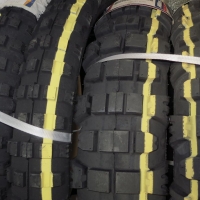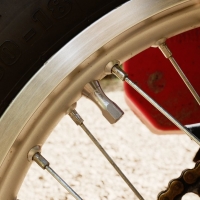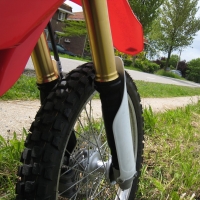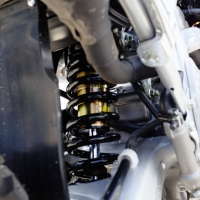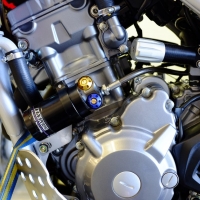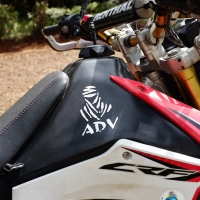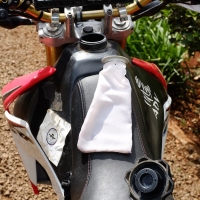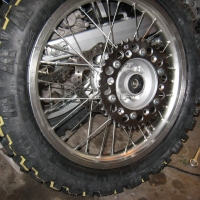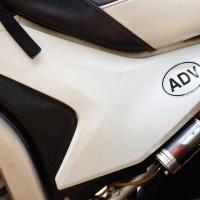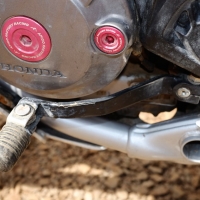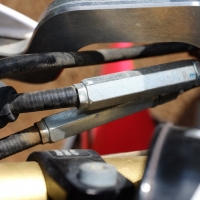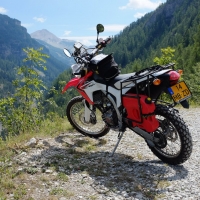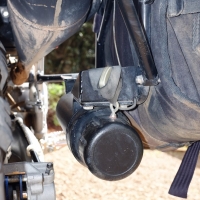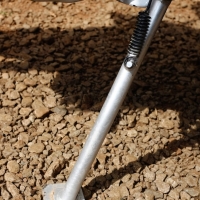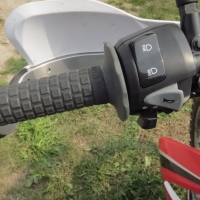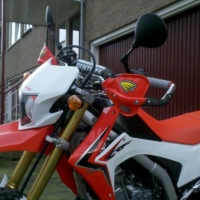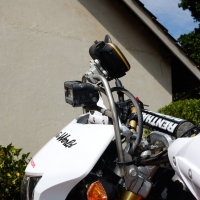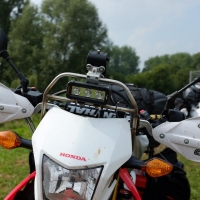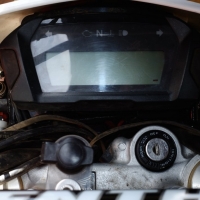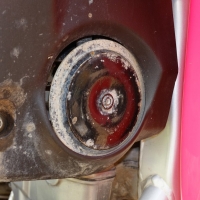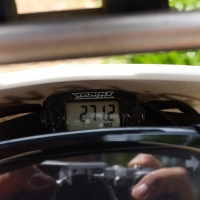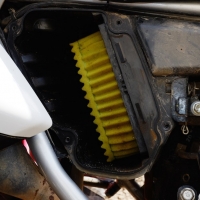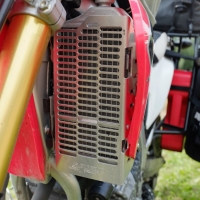Honda CRF250L
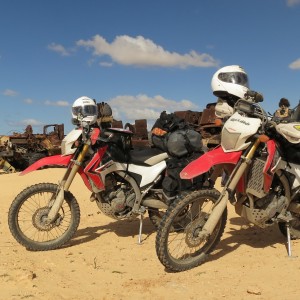 We both travel on a Honda CRF250L (specifications: 250cc, 144 kg curb weight, liquid-cooled, 4-stroke, single cylinder, DOHC, fuel-injection).
We both travel on a Honda CRF250L (specifications: 250cc, 144 kg curb weight, liquid-cooled, 4-stroke, single cylinder, DOHC, fuel-injection).
We are very happy with the CRF. It is not heavy (144 kg) and extremely agile. They perform well in all conditions we have encountered so far: heat, rain, altitude, dust. Offroad we really enjoy riding the light CRF. Deep sand, loose stones, coarse gravel, steep slopes, river crossings, all without any problems. The CRF is also very economical and runs 3.3/100 km.
The top speed is 120 km/hour, but that is not comfortable without a windshield. We only experienced this downside on the motorway in Europe and North America. In Africa and South-America, we do not drive faster than 90km/hour on the main roads. Where possible, we try to avoid riding on motorways, because we like riding on the smaller backroads. On these roads a high speed is not necessary.
Maintenance
The service interval of the CRF250L is long. Honda prescribes that the oil should be changed every 12,000 km and the spark plug only after 48,000 km. And this works out really well. Peter replaces the oil and oil filter every 10,000 km. He cleans the foam air filters every 4,000 km or earlier if this is necessary after riding dusty roads. He sets the valves every 24,000 km and replaces the chain and sprockets every 30,000 km. The long service interval is a good quality for any travel motorbike, because is does not only take less time to do the maintenance, it also costs less money.
“Problems”
Apart from regular maintenance and replacement of wear parts, we have had some bigger problems. Most of those on Peters bike and usually related to after-market (non-Honda) parts. Although we say ‘problems’, we never experienced them as such. Until now we have always been able to solve them on the road and continue our trip. 
- 11,000 km (Ethiopia) – Motorbike Leonie – Leaking gasket between fuel pump and non-original (IMS) tank: The shape of the tank did not fit perfectly on the pump. It was easy to fix with liquid gasket.
- 15,000 km (Ethiopia) – Both motorbikes – Play between the front sprocket and the output shaft: The non-original 13-tooth front sprocket brand JT did not fit perfectly to the shaft, which had caused wear on the output shaft. We probably had a bad batch of JT sprockets, because the new JT front sprockets we use since then fit better. However, due to the wear on the output shaft, all new sprockets have a little play. In order to prevent further wear on the output shaft, Peter glues the sprockets to the shaft with Locktite 638.
- 40,000 km (Argentina) – Motorbike Leonie – Leaking seal in the shock: The seal is a wear part of the shock. We should have replaced it after 20,000 km -in line with the instructions of the manufacturer (Hyperpro)- , but we had not done so. Peter could replace the seal, solving the problem. A few thousand kilometers after that he preventively replaced the seal of the shock in his bike in Chile. After this, we waited another 40,000 km to replace the seals in the shock of both bike, until a big maintenance stop in Canada at 77,000 km. After that Peter replaced the seals on both bikes in Kyrgyzstan at 96,000 km, after the seals started leaking a bit of oil again.
- 53 000 km (Bolivia) – Motorbike Peter – Defect automatic chain tensioner:
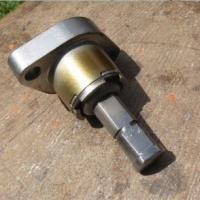 We were not able to buy a new tensioner. Instead Peter had an extension welded to the original chain tensioner, so the cam chain could be tightened again. After some time the problem came back. In Ecuador we were able to buy a new chain tensioner, which Peter placed after 60,000 km. During big maintenance in Canada (after 77,000 km) Peter has places a new cam chain and a new manual chain tensioner. The cam chain and chain tensioner in Leonie’s bike work without any problems.
We were not able to buy a new tensioner. Instead Peter had an extension welded to the original chain tensioner, so the cam chain could be tightened again. After some time the problem came back. In Ecuador we were able to buy a new chain tensioner, which Peter placed after 60,000 km. During big maintenance in Canada (after 77,000 km) Peter has places a new cam chain and a new manual chain tensioner. The cam chain and chain tensioner in Leonie’s bike work without any problems. - 57,000 km (Peru) – Motorbike Peter – Torn piston band in front fork suspension: The suspension in the front forks of Peter’s bike was not working anymore. We were not able to buy a new piston band. Instead Peter had a mechanic machine a deeper and wider groove in the piston of the damper to fit a new piston band he made from a tie-wrap. This solutions still works.
- 77,000 km (Canada) – Motorbike Peter – New piston and cylinder: Around 50,000 km Peter’s bike started using oil, using more gasoline and losing compression.
 It appeared that the air filter had not been in the right place, allowing dirt to get into the engine. The difference in performance between the two motorbikes was very noticeable. Leonie her bike was faster, did not use oil and also used less gasoline. During an ‘open heart surgery’ in Canada Peter replaced the piston and cylinder in his bike. Despite the noticeable decreasing performance, the old cylinder still looked very good. With the new piston and cylinder the engine now runs perfectly.
It appeared that the air filter had not been in the right place, allowing dirt to get into the engine. The difference in performance between the two motorbikes was very noticeable. Leonie her bike was faster, did not use oil and also used less gasoline. During an ‘open heart surgery’ in Canada Peter replaced the piston and cylinder in his bike. Despite the noticeable decreasing performance, the old cylinder still looked very good. With the new piston and cylinder the engine now runs perfectly. - 98.000 km (Kyrgyzstan) – Motorbike Leonie – Broken tiny spring in the piston of the front suspension: The front suspension on Leonies bike did not feel right. It still worked, but not as it was supposed to. Peter took it apart and found out that a tiny spring in the one-way-valve of the piston in the damper had broken. He was able to ‘Mc-Guyver’ a tiny new spring from the spring of a ballpoint pen. It works like a charm!
- 98,000 km (Kyrgyzstan) – Motorbike Peter – New battery: First the dashboard started to blink when starting the bike, then the bike started to hold back when riding and after a while the bike would not start at all. A new battery quickly solved this.
 101,000 km (Tajikistan) – Both motorbikes – Clocked fuel pumps Riding the Pamir Highway the bikes suddenly started to behave very strange: holding back or even stopping completely. Even after draining the tank, using injector cleaner and cleaning the injector the problem was not solved. It turned out that the filters of the fuel pumps on both bikes were clocked, probably due to a combination of bad fuel and dirt. Part of it was the liquid gasket that we used in Ethiopia to fit the fuel pump to the tank, which had now dissolved due to bad fuel. Peter removed both fuel pumps from the tanks, took them apart and cleaned both of them. The bikes are running perfectly again.
101,000 km (Tajikistan) – Both motorbikes – Clocked fuel pumps Riding the Pamir Highway the bikes suddenly started to behave very strange: holding back or even stopping completely. Even after draining the tank, using injector cleaner and cleaning the injector the problem was not solved. It turned out that the filters of the fuel pumps on both bikes were clocked, probably due to a combination of bad fuel and dirt. Part of it was the liquid gasket that we used in Ethiopia to fit the fuel pump to the tank, which had now dissolved due to bad fuel. Peter removed both fuel pumps from the tanks, took them apart and cleaned both of them. The bikes are running perfectly again.
Despite these problems, the CRF250L have never really let us down. Even after 100.000km we can say that we have never really been stranded, the bikes have never been on a trailer and we did not ride one kilometre less because of the above mentioned defects. We would choose these bikes again tomorrow for a trip around the world!
(Last update 16-08-2016)
Modifications
To prepare the bikes for this long trip, we made quite some modifications. Please find an overview of the modifications below (Hover over a photo for the modification or click on a picture for more details )













